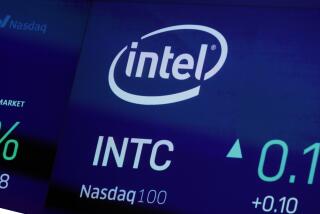The man who manufactured a chip behemoth
- Share via
It has been a revolutionary year for Intel.
The single microprocessor it invented in 1971 has divided itself into two central cores and this month two became four with the introduction of Intel’s first quad-core product.
The chip with four brains was launched the same time as a book that describes the human brains behind the success of the world’s biggest semiconductor maker.
Although two others founded the company, one established it as a manufacturing titan. He is Andy Grove, 70 this year and the focus of Richard S. Tedlow’s new biography.
Grove, who became Intel’s chief executive in 1987, is most likely to be remembered for his management approach, expressed in his book “Only the Paranoid Survive.”
Tedlow, aided by access to Grove’s notebooks, tells the story of the experiences from which these ideas were distilled.
Andy Grove was born Andras Grof in Budapest in 1936. His father, George, who ran a dairy business in the Hungarian capital, was called up to a Jewish labor battalion in the Hungarian army and sent to the eastern front in 1942. He was listed as missing a year later.
Andy and his mother, Maria, moved around Budapest and Hungary to avoid being sent to Auschwitz. They were miraculously reunited with George in 1945, when he returned from a Russian prison camp.
As the Soviet Union brutally repressed the Hungarian uprising in 1956, the 20-year-old Grove escaped to Austria and then persuaded the International Rescue Committee to give him passage to the United States.
In Grove’s eyes, this is where his life began. Hungary has nothing but unpleasant memories for him and he has never returned. (He eventually had the means to bring his mother and father over to join him.) His 2001 memoir, “Swimming Across,” recounts the experiences of his first 20 years.
The rest of the story, as Tedlow says, is best characterized as “living the American Dream.” Grove’s charitable foundation shows his belief in this aspiration, with its stated purpose of “defending, reviving, bolstering the American Dream.”
Grove gathered early impressions of the land of opportunity at the City College of New York, where he studied chemical engineering. There he adopted the no-nonsense approach of a favorite professor that was to become his own trademark in business.
He arrived in the San Francisco Bay Area on a honeymoon drive across the U.S. with Eva, the Austrian-born woman whom he married in 1958.
Completing a PhD at UC Berkeley, he went on to teach there, publishing a 366-page textbook, “Physics and Technology of Semiconductor Devices.”
At the same time, he was working at Fairchild Semiconductor, a chaotic start-up whose “Fairchildren” have gone on to form numerous microchip companies of their own.
Two of these -- Robert N. Noyce, the co-inventor of the microchip, and Gordon Moore, who coined Moore’s Law on the expansion of computing power and ebbing of costs -- formed Intel in 1968. It was a memory chip company then, and Grove was the first to join.
This is the most colorful phase of Grove’s story, a time when Silicon Valley was the Wild West of entrepreneurship, where management was almost non-existent, products failed and quality standards were sometimes laughable.
In contrast to today’s “clean rooms” for chip making populated by bunny-suited workers, Intel’s first factory was highly contaminated, with employees reheating dinners in its ovens and holding late-night parties.
Noyce and Moore may have been inspirational geniuses, but they were not great managers.
It was left to Grove to drive the manufacturing process forward and make the decisions that helped to lift the value of the company from $3 million in 1968 to $500 billion at its peak.
Craig Barrett succeeded him as chief executive in 1998 and took Intel’s manufacturing might to another level.
“Without Andy Grove, Intel might have been a less intense, more friendly company, but it would also be a smaller, less profitable company,” Moore tells Tedlow.
Unlike Tim Jackson, author of “Inside Intel,” Tedlow does not dwell on Grove’s mercurial temper, which alienated many people, nor on Intel’s questionable tactics to preserve its microprocessor dominance.
Neither does he delve into a personal life that Grove has always tried his utmost to keep private, although there is an account of his battle with prostate cancer and the revelation that he has Parkinson’s disease.
But Tedlow, who received full cooperation from his subject, does suggest an answer to the central question of why Intel has always failed when it tried to diversify away from the microprocessor and the personal computer.
Grove’s focus had been total, he reveals. “The PC was it,” in Grove’s words, and the microprocessor was the crown jewel.
Intel has been blinkered to success elsewhere because of a weakness that can also be viewed as a strength: Microprocessors and the PC are still very good businesses.
As Andrew Carnegie, often quoted in this book, advised: “Put all your eggs into one basket and then watch that basket.... The great successes of life are made by concentration.”
*
Chris Nuttall is a San Francisco-based technology correspondent for the Financial Times, in which this review first appeared.
*
No nonsense
Andy Grove: The Life and Times of an American
By Richard S. Tedlow
Portfolio, $29.95; 568 pages
*
Source: Publisher
More to Read
Sign up for our Book Club newsletter
Get the latest news, events and more from the Los Angeles Times Book Club, and help us get L.A. reading and talking.
You may occasionally receive promotional content from the Los Angeles Times.










